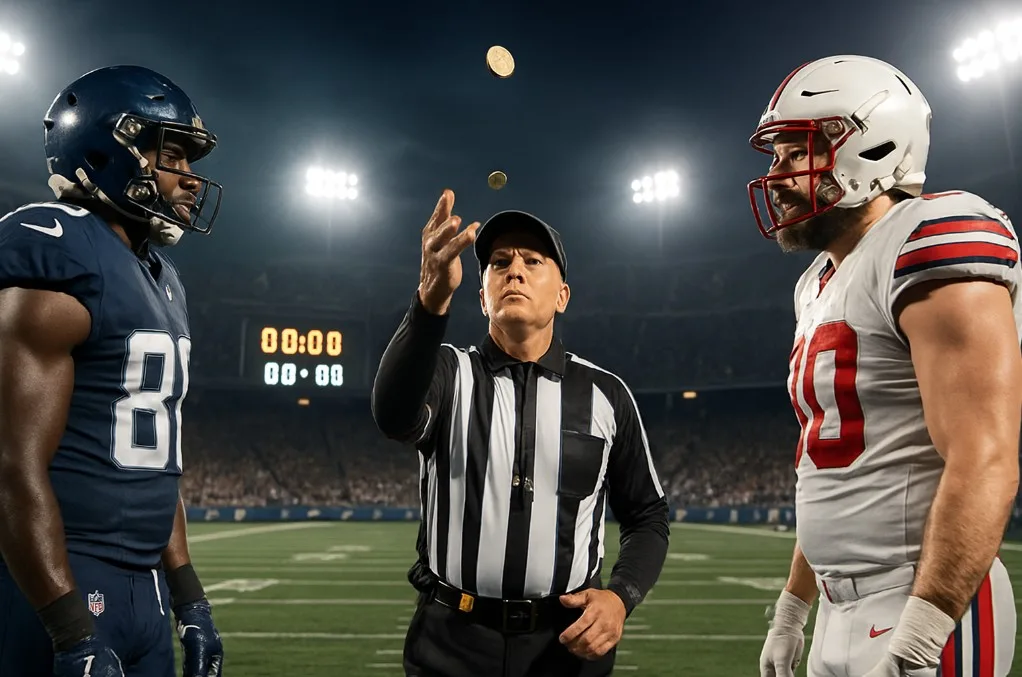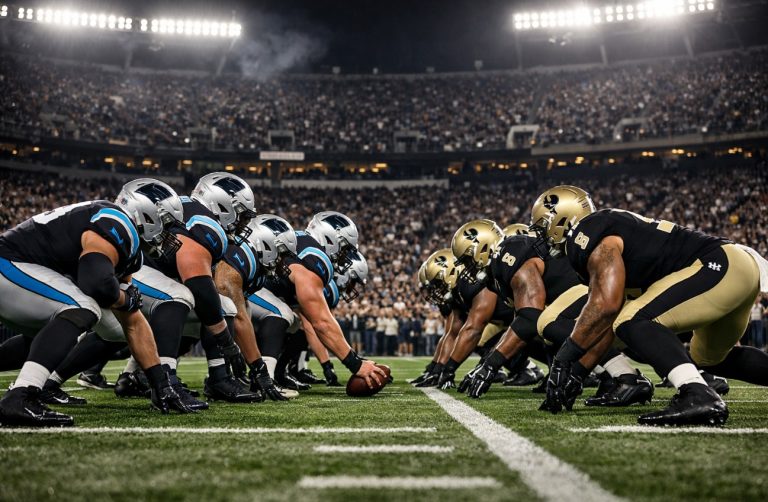Overtime Rules NFL: How the 2025 Reforms Changed the Game?
When two American football teams finish regulation with the same score, how is a winner decided? This is where the National Football League’s overtime rules come into play, and they are far from straightforward.
Over the years, these rules have been repeatedly altered, often in response to controversies or growing concerns about player safety. For fans in the UK, who are more familiar with football matches that can simply end as a draw, the complexity of NFL overtime can be puzzling.
Understanding the system is not only essential for following the sport but also for appreciating the drama that comes with a tightly fought contest.
How Do Overtime Rules Work in the NFL Regular Season?
At the end of regulation, if both teams are tied, the referee holds a coin toss to decide who takes the first possession in overtime. The visiting captain is given the opportunity to call the toss. What follows is a single overtime period lasting 10 minutes, reduced from the original 15 in 2017 to protect player health and reduce the risk of injuries.
The most recent reforms now guarantee that both teams get at least one possession. The only exception is if the defence produces a game-ending play immediately on the opening drive, such as returning an interception for a touchdown or recording a safety.
If the first team fails to score or only manages a field goal, the other side then has its chance. Once both teams have had their possessions, the next score of any kind secures the victory.
If no winner emerges after the 10-minute overtime, the result is recorded as a tie. This outcome remains a unique feature of the NFL’s regular season and can often have an impact on the playoff race, since a tie is treated as half a win and half a loss in the standings.
Another feature of regular season overtime is that each team is only granted two timeouts. In addition, coaches cannot challenge plays. Instead, reviews are initiated exclusively by the replay official, a measure designed to keep the game moving at a reasonable pace.
How Are Overtime Rules Different in the NFL Postseason?
While ties may be tolerated in the regular season, the same cannot be said for the playoffs, where a definitive winner must be declared. The NFL postseason overtime system therefore has several crucial differences.
If the score remains tied after an overtime period, or if the second team has not finished its first possession, another period begins after a two-minute break. This process can repeat as many times as necessary. Importantly, there is no halftime intermission following the second overtime period; play simply continues until one team wins.
The procedure for coin tosses also adapts. The team that lost the initial overtime coin toss is given the first choice of possession or field direction in the following period, unless the winner of the first toss deferred. This ensures a fair balance across multiple extra periods.
Each side is allowed three timeouts per half, offering more flexibility than in the regular season. The timing rules used in regulation apply to the second and fourth overtime periods as well. If, after four overtimes, the score is still tied, the referee conducts another coin toss and the game carries on.
Some of the most intense games in NFL history have unfolded under these conditions. For example, in the 2013 AFC Divisional Playoff between the Denver Broncos and the Baltimore Ravens, the contest stretched deep into double overtime before the Ravens emerged victorious, highlighting just how relentless postseason football can be.
How Have NFL Overtime Rules Changed Over the Years?

The story of NFL overtime rules is one of constant revision. The earliest system, introduced in 1974, was sudden death. In this format, the first team to score in overtime by touchdown, field goal, or safety immediately won the game. Although it created dramatic finishes, critics soon noted that winning the coin toss provided a disproportionate advantage.
In 2010, the league made its first major adjustment by installing a modified sudden-death system for the postseason. Teams were no longer able to secure an instant win with a field goal on the opening possession.
If that happened, the opponent had to be given a chance to respond. Two years later, in 2012, the NFL expanded this rule to cover all games, ensuring greater fairness across the league.
The next big change arrived in 2017, when the overtime period in regular season games was shortened from 15 minutes to 10. This decision was rooted in concerns for player safety, as shorter games meant fewer plays and less fatigue, particularly for teams facing quick turnarounds before their next fixtures.
Controversy struck again in 2020, when the Buffalo Bills lost to the Kansas City Chiefs in the playoffs without ever touching the ball in overtime. The Chiefs had won the toss, scored a touchdown, and advanced.
Outrage from fans and analysts led to another modification in 2022, this time guaranteeing both teams a possession in the postseason, no matter what happened on the first drive.
Finally, in 2025, the NFL brought its rules into alignment by extending this guarantee to the regular season as well. Now, whether in September or January, both teams will always receive the ball at least once, unless the defence scores immediately on the opening drive.
Why Was the 2017 Shortening of Overtime Controversial?
When the league reduced overtime from 15 to 10 minutes in 2017, it was met with mixed reactions. Proponents argued that fewer plays would reduce the strain on players, especially during a long season. However, critics pointed out that a shorter period would increase the likelihood of ties, something that does not sit well with either players or fans.
Indeed, in the very next season, the Cleveland Browns and Pittsburgh Steelers played to a 21-21 draw in a 10-minute overtime, a reminder of the rule’s direct impact. Although ties remain rare, they add a unique wrinkle to NFL standings and occasionally prove decisive in playoff qualification.
Why Did the NFL Introduce the 2022 Postseason Change?
The 2022 change stemmed from frustration over playoff games being decided before both teams had a fair chance. Under the older format, if the team that won the toss scored a touchdown on its opening possession, the game ended immediately. This felt unjust, especially in contests where both sides had potent offences.
The most notorious example came in the 2020 AFC Divisional Playoff between the Bills and the Chiefs. Kansas City won the toss and scored a touchdown, leaving Buffalo, whose offence had been explosive throughout the game, on the sidelines without a response.
This incident became a turning point. Fans, coaches, and players across the league demanded reform, and the NFL responded by ensuring that, starting in 2022, both teams would always get the ball in postseason overtime.
What Did the 2025 Reform Change for Both Regular Season and Postseason?

The 2025 reform marked one of the most significant developments in NFL overtime history because it brought complete consistency across the board. Now, in both the regular season and the playoffs, each team is guaranteed at least one possession.
In the regular season, the 10-minute limit still applies. This means that while both teams get the ball, a tie remains possible if the score is still level when time expires. In the postseason, there is no such restriction, and play continues with as many extra periods as required.
The rule does allow for a game to end during the first possession, but only if the defence forces an immediate turnover that results in a touchdown or a safety. In effect, the reform eliminated the possibility of an offence winning a game outright without the opponent ever touching the ball.
How Do NFL Overtime Rules Compare to College Football?
College football in the United States employs an overtime format that bears little resemblance to the NFL system. Each team begins possession at the opponent’s 25-yard line, and they alternate until one outscores the other in a round.
If the game extends beyond the second overtime, teams are often required to attempt two-point conversions after touchdowns, making the format even more intense.
This system has produced marathon contests. In 2021, Illinois and Penn State required nine overtimes before Illinois finally claimed victory, a record for college football. While the format guarantees equal possessions and dramatic finishes, critics argue it strays too far from traditional gameplay.
The NFL has resisted adopting this structure, preferring to preserve the time-based format of professional football while still ensuring fairness.
What Have Been the Most Controversial NFL Overtime Moments?

Controversy has followed NFL overtime from the very beginning. The 1998 NFC Wild Card game between the Green Bay Packers and the San Francisco 49ers ended in sudden death after the 49ers scored on the first possession, fuelling early criticisms of the format.
The 2010 NFC Championship between the Minnesota Vikings and the New Orleans Saints was another flashpoint. The Saints scored on their first drive in overtime, ending the game without the Vikings’ offence taking the field. This outcome directly contributed to the 2010 modification.
More recently, the 2020 playoff clash between the Bills and the Chiefs reinforced the need for change, as discussed earlier. Each of these examples demonstrates how controversial results have been the driving force behind significant reforms.
What Might the Future Hold for NFL Overtime Rules?
Although the 2025 reforms have brought balance and fairness, the NFL may not be finished tinkering. One possibility is the extension of regular season overtime back to 15 minutes, which would reduce the number of ties.
Another idea occasionally discussed is the removal of the coin toss as the deciding factor for first possession, perhaps replacing it with a system tied to game statistics, such as total yards or turnovers.
The league also frequently experiments with variations in preseason or developmental leagues, leaving open the possibility that new innovations could one day find their way into the NFL itself. For now, the system has reached a stable point, but history suggests that changes will inevitably return.
Conclusion
For UK fans exploring American football, the NFL’s overtime rules can at first appear unnecessarily complex. Yet they are central to the sport’s drama, often producing the most memorable and debated moments in league history.
The journey from sudden death in 1974 to the fairness-focused reforms of 2025 demonstrates the league’s willingness to evolve. Today, both regular season and postseason games guarantee each team a possession, reducing controversy and ensuring fairer competition.
Whether through ties that influence playoff races, defensive heroics that end contests instantly, or marathon postseason thrillers, overtime adds an extra layer of intensity to America’s most popular sport. For British fans tuning in late at night to watch, knowing these rules not only enriches the experience but also provides insight into how the NFL balances tradition, safety, and entertainment.
FAQs
What happens if an NFL regular season overtime ends without a winner?
The game is officially recorded as a tie, which counts as half a win and half a loss in the standings.
How long can an NFL playoff game go?
There is no limit. Play continues through as many overtime periods as needed until a winner is declared.
Why did the NFL introduce modified sudden death in 2010?
It was designed to reduce the advantage of winning the coin toss and immediately ending the game with a field goal.
How many timeouts are allowed in overtime?
In the regular season, each team is allowed two timeouts, while in the postseason, each side gets three per half.
What is the fastest way a game can end in overtime?
If the defence scores a touchdown or records a safety on the opening possession, the contest ends immediately.
Why was the 2025 reform significant?
It unified regular season and postseason rules, ensuring both teams are guaranteed a possession in all overtime games.
How do ties affect playoff chances?
Ties count as half a win and half a loss, which can influence final standings and determine qualification for the playoffs.







